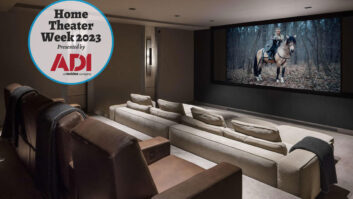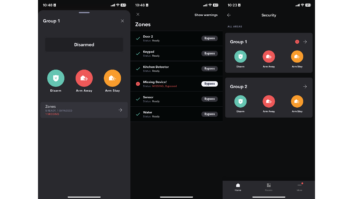One of the prominent themes emanating from this year’s consumer electronics show (CES) held in Las Vegas last month was that digital audio and video content stored on the increasing number of computers in people’s homes will be networked to home entertainment centers. It’s clear that the high-quality digital content that homeowner’s are producing in the form of digital music recordings, personal digital photos or personal digital videos benefit from larger viewing displays and higher quality speaker systems than those provided by relatively small computer screens and localized computer speakers.
All of the major consumer electronic manufacturers recognize that the convergence of computing content with home theater and audio systems will become a very significant portion of their business. They envision that today’s homeowner will want an easy way to:
*Show digital photos on their large-screen family room or home theater television
*Play digital MP3 music in the surround-sound home theater location and throughout the entire home (if the home supports distributed audio)
*Play personal video recordings on large-screen televisions and easily move digitally recorded content from one television to another.
To accomplish these objectives I will review the different products and strategies that various manufacturers have developed to date.
Wireless Entertainment Access Points. The digital content stored on home computer hard drives can be wirelessly transmitted to the home’s entertainment system. Sony and Intel are predicting that customers will want to deliver their digital content wirelessly over an 802.11a wireless backbone instead of a wired connection. Both have introduced wireless products that can connect to various computers in the home, find the appropriate digital audio and video content and play them back through a locally attached large-screen televisions or home stereo systems. To date, most of these products only support composite and/or S-video output, but I anticipate that support will be available for component output by the end of the year or early next year. A company called Magis Networks (www.magisnetworks.com) showcased an impressive wireless transmission (called Air5) of a high-definition signal in their booth, and they have partnered with several major large-screen manufacturers (such as Samsung) to incorporate this technology into their HDTV monitors.
Wired Entertainment Computing Platforms. For the wired home (specifically those with Category 5, 5e or 6 cabling) there are a number of product offerings that will bring the computer’s digital content to the home theater and entertainment products. Microsoft’s Media Center software is now loaded on a variety of high-speed computing platforms that can easily accomplish this task (for more information on this subject, please see the January column on this product). At the CES show several new manufacturers announced that they will be selling computing platforms running Microsoft’s Media Center Edition software. Some of the computers look more and more like audio/video components (as they should), as evidenced by product introductions from iBuyPower (http://www.ibuypower.com/confirm/configurator-media.htm) and Tagar (www.tagarsystems.com/dezinor). These are the only media server products available today that will support component video out as well as 5.1 surround sound.
The non-Microsoft approach to computer-based media centers is best exemplified by products introduced by SONICblue (the Replay TV) and by TiVO. TiVO showcased their Series 2 network upgrade option ($99 retail) which allows the homeowner to access all of their digital photos and music from any computer on the network and display the pictures or song titles on the monitor connected to the TiVO. The network connection also allows you to move recorded content among various TiVOs in the home and will allow TiVO owners to connect to their TiVO remotely from the Internet and set its recording options.
If you don’t need the horsepower (or expense) of a full computer to distribute the audio and video content of your computers, several companies are upgrading traditional home theater equipment and adding a wired Ethernet port. For less than $50 (added to the retail value of a DVD or CD player), these companies have included network connectivity to their audio/video product lines to provide access to in-home digital content. Apex Digital displayed a product integrated with Digital 5 solutions(www.digital5.com/solutions.html) that enhanced a standard DVD player and added an Ethernet port to the device so that it could retrieve audio and video content from home computers. Prismiq (www.prismiq.com) demonstrated a product that accomplishes the same task without a DVD player. Prismiq’s products are simply devices that you can connect to any television in the home to display computer video content or play MP3 music in that given room.
Controlling the digital content. The challenge to all of this exciting new content the home televisions and receivers is controlling what the homeowner wants to see and hear in a given room. All of these companies have developed their own infrared remotes to help the customer navigate to the digital content that they want to enjoy. Doing this well requires a set of simple IR commands and an effective on-screen display to help the homeowner navigate through their options. Each company has its own method for accomplishing this goal and it is important that the integrator understand the different control methods to pick the product best suited for a given custom installation. Also, keep in mind that these products introduce yet another remote to the already complex array of remotes in the crowded home theater space. To solve this problem, a company called Harmony (based out of Ontario, Canada, www.harmony-remote.com) has developed a “web-smart,” universal remote that can be easily configured via their web IR and macro database. Once the online configuration is completed it is downloaded to the Harmony remote control via the computer’s USB port.
Clearly this is an exciting time for the electronic home integrator who can provide complete home audio, video and data solutions. In-home digital content from digital cameras, digital video recorders, PVRs and/or MP3 music needs to be connected to legacy A/V platforms located throughout the home. It requires a well-designed home network and integration effort to effectively deliver on the promise of distributed, whole-house digital audio and video content. Professionals in the custom electronics industry are well positioned to take advantage of this integration opportunity if they understand the principles of data distribution along with their existing knowledge of audio/video distribution.
Gordon van Zuiden ([email protected]) is president of cyberManor, in Los Gatos, California.






